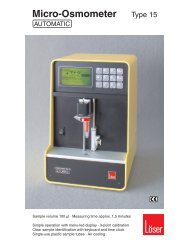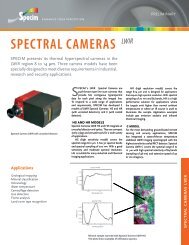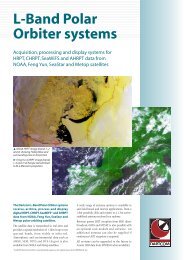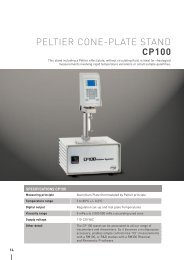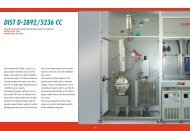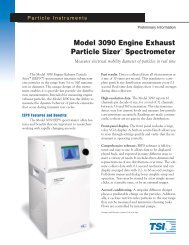Model 3475 Condensation Monodisperse Aerosol Generator
Model 3475 Condensation Monodisperse Aerosol Generator
Model 3475 Condensation Monodisperse Aerosol Generator
Create successful ePaper yourself
Turn your PDF publications into a flip-book with our unique Google optimized e-Paper software.
Operation<br />
The <strong>Model</strong> <strong>3475</strong> CMAG uses a controlled condensation<br />
technique to produce monodisperse aerosols.<br />
Based on the Sinclair-LaMer principle, this operational<br />
approach involves condensing a vapor onto condensation<br />
nuclei.<br />
Using nitrogen as the carrier gas, an atomizer inside<br />
the CMAG produces a spray from a low-concentration,<br />
aqueous solution of sodium chloride. The droplets<br />
pass through a drying column, where they dry to form a<br />
high-concentration nuclei aerosol. The condensation<br />
nuclei travel to a thermostatically controlled saturator<br />
vessel and bubble through a substance with low volatility,<br />
such as diethylhexyl sebacate (DEHS), dioctyl phthalate<br />
(DOP), Emery 3004, or paraffin or carnauba waxes.<br />
The carrier gas, nuclei, and vaporized substance<br />
move from the saturator into a reheater unit, which<br />
serves to ensure that the aerosol material is completely<br />
vaporized. From the reheater unit, the nuclei and vapor<br />
move into an air-cooled condensation chimney. It is<br />
here that, once a preset supersaturation level has been<br />
reached, the controlled heterogeneous condensation<br />
process begins, resulting in a highly monodisperse<br />
aerosol.<br />
Mean particle size is dependent on the ratio of<br />
the vapor concentration to the nuclei number concentration.<br />
You can control vapor concentration, and<br />
therefore, particle size by adjusting the saturator temperature<br />
and the proportion of the total flow passing<br />
through the saturator unit.<br />
The CMAG allows you to make very rapid<br />
changes to particle size over a limited range by varying<br />
the saturator flow rate alone. For instance, with DOP<br />
or DEHS, only three different temperature settings are<br />
required to cover the range from 0.1 to 5 micrometers.<br />
The generator’s specially designed aerosol outlet meets<br />
the requirement for high monodispersity by selecting<br />
the central flow where the temperature gradient is lowest<br />
and, consequently, the size distribution is narrowest.<br />
To produce monodisperse aerosol with particles up to 8<br />
micrometers, you must divert a portion of the nuclei<br />
through a filter, reducing the nuclei number concentration<br />
in a controlled manner until you achieve a higher<br />
relative concentration of vapor.<br />
Concentration (particles/cm 3 )<br />
10 4<br />
5×10 3<br />
0<br />
0.7 1 2 3 5 7 10<br />
Aerodynamic Particle Diameter (µm)<br />
<strong>Monodisperse</strong> aerosol produced by the <strong>Model</strong> <strong>3475</strong> using the reduction<br />
of the nuclei number concentration<br />
Flowmeter<br />
(total)<br />
Flowmeter<br />
(screen-bypass)<br />
Flowmeter<br />
(saturator)<br />
Reheater<br />
Screen<br />
HEPA Filter<br />
Heated Saturator<br />
N 2<br />
Flow<br />
Valve<br />
Diffusion<br />
Dryer<br />
Flow Valve<br />
Flow Valve<br />
<strong>Condensation</strong><br />
Chimney<br />
Atomizer<br />
<strong>Monodisperse</strong><br />
aerosol out




